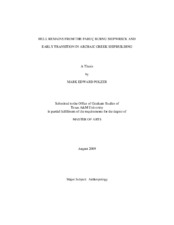| dc.description.abstract | In 2002 and 2003, the Institute of Nautical Archaeology excavated the remains of an East Greek ship that sank off the coast of Pabuç Burnu, Turkey, sometime in the second quarter of the sixth century B.C. The scant remains of the vessel’s hull have provided the first archaeological evidence for laced shipbuilding in the Aegean. The diagnostic features preserved in the hull fragments are consistent with those of Greek laced construction, as evidenced in other shipwrecks from the same period found in the western Mediterranean. The planking joinery included edge inserts, or coaks, between the planking strakes and ligatures laced through oblique holes drilled along the sides of the planks through tetrahedral notches. The ship’s framing consisted of pre-fashioned made-frames alternating, on the upper sides of the hull, with top-timbers. The frames had trapezoidal sections, were notched over the planking seams on their underside, and were lashed to the hull. The top-timbers had rectangular sections and were both lashed and treenailed to the planking. Notable in this vessel’s construction is the use of tenons as coaks in its original construction, the earliest example of tenon usage in Greek shipbuilding. The hull’s construction features are virtually identical to those of the Cala Sant Vicenç wreck in Majorca, and mostly similar as well to those of wreck 1 at Gela. The Pabuç Burnu and Cala Sant Vicenç ships are further similar in the use of traditional cylindrical dowel coaks for making repairs to the hull, wherein they are inserted obliquely along one side through the face of the replacement plank. These features testify to a critical phase in Greek shipbuilding when tenons replaced dowels as coaks in laced construction, paving the way for the eventual supplanting of lacing by pegged mortise-and-tenon joinery. Furthermore, examination and comparison of numerous construction details of these and other Greek shipwrecks from the sixth through fourth centuries B.C. suggest that mortise-and-tenon technology could have evolved naturally within the Greek tradition of laced construction, rather than being incorporated directly from some foreign—most likely Phoenician—shipbuilding method. | en |


